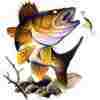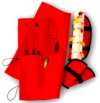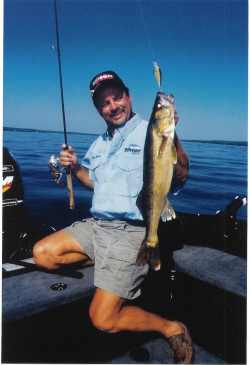
|
|||

Check out our New T-shirt Line 
Click here to see Beckmans New Bottom Bouncer Leader and Lure Wrap Kit Promotional Team Favorites Lodging food and more
|
By JOHN KOLINSKI John Kolinski is the 2002 Professional Walleye Trail Angler of the Year, last year's Illinois River RCL winner and a 13-time championship qualifier on the PWT, RCL and Masters Walleye Circuit. His articles can be read in numerous Midwestern outdoor publications and several web sites. Kolinski is sponsored by Triton Boats, Mercury Motors, Lowrance Electronics, Normark/Storm Lures, MinnKota, Lindy Legendary Tackle, Flambeau, Tempress Rod Holders, Off-Shore Planer Boards, Berkley Trilene, Optima Batteries and Panther Marine.
There are no firm and fast guidelines that tell you when to get moving. Sometimes, it's another angler who tips you off by flopping walleye after walleye into the bottom of the boat. Sometimes, it might be a pattern of strikes on your outside Off-Shore planer boards, which will pick up speed while the inside boards slow down as you make a turn. Other times, it's a matter of experimenting. When the hot-weather trolling bite isn't as fast as I'd like it to be but my Lowrance X-19 sonar unit tells me there are walleyes in the vicinity, I throttle up my four-stroke Mercury 9.9 Bigfoot kicker and make a few passes at 4-5 mph. It's a great way to cover water quickly and pick off the most aggressive fish. Iíve got my kicker set up on a Panther Marine jackplate that allows me to raise it or lower it from the driverís seat. Itís in the water and ready to fish by the time I shut down my 225 Merc, or I can raise it up while I get the big engine warmed up to relocate. There are a few conditions that must be present for speed-trolling to be effective. Foremost is water with several feet of visibility. If you are moving quickly, the fish needs to be able to see the color and flash of your crankbait, as well as sense its vibration and movement. Since these fish are usually scattered over large flats or along extended breaklines, they may have to travel a considerable distance to eat your lure. In dirty water, they can't always get a good fix on a fast-moving bait. Secondly, itís been my experience that trolling at wake speeds works best during periods of stable weather when the fish are active. Cold fronts tend to put walleyes in a negative mood and push them tight to structure where the best way to catch them is by wiggling live bait in their faces. On the other hand, water temperatures arenít always a good indicator of when to pick up the pace. In general, itís a warm-water pattern, but it shouldnít be overlooked any time when walleyes seem to be active and aggressive. That even includes the spring months of March and April on Midwestern river systems. On both the Mississippi and Illinois rivers, Iíve seen situations where speed-trolling or working downstream with crankbaits is more productive than any other presentation. Sometimes, going with the flow is a way to catch a few bonus fish in those river situations. While everyone else is pulling in their lures and running back downstream to set up for another pass, you might be able to keep producing walleyes and sauger by turning around and making a run with the current. One easy mistake to make is not trolling fast enough when going downstream. You need to be moving at roughly twice the current speed to keep your lures working effectively when traveling downstream. During an In-Fisherman Professional Walleye Trail tournament on Lake Francis Case in Chamberlain, S.D., in May, we were working on fish in the tailrace area below the dam at the north end of the impoundment. When the turbines were pumping water and the current was moving, we caught plenty of fish trolling upstream. However, when the water flow diminished, we found that trolling 3 ½-4 mph downstream became more effective. Keep those lures pounding the bottom as much as possible, depending on snags and debris. I canít count the times when my baits have banged the bottom and been inhaled after hanging up for just a second. If trolling downstream doesnít work, so be it, but if it does, you could be onto something bit. Not all lures work effectively at increased rates of speed. The best tend to have tight wobbles and thin profiles. Iíve had great success with Rapalaís Shad Raps and Stormís ThunderCranks. Stickbaits like Rapalaís Husky Jerks and Countdown Rapalas pull well at high speeds, too, when fished on lead-core line. Lures with big bills or wide profiles generally donít work well at higher rates of speed. No matter what lures you choose, itís imperative that you tune them carefully so they donít kick out to the side where they can foul other lines or run so erratically they donít look natural. To see how a lure is running at high speed, let about six feet of line out, drop the bait in the water next to the boat and sweep it aggressively forward. If itís not running in a straight line as you pull it forward, it needs to be tuned. Tuning lures is a matter of adjusting the eye where the swivel clips to the lure. Whatever direction the lure is pulling, bend the eye slightly in the opposite direction until it runs perfectly straight. When I know Iím going to be fishing crankbaits, I like to tune a dozen or so in different colors and models before I begin fishing, then put them in one of my Flambeau TuffTainer tackle boxes with Zerust Dividers for that dayís outing. Rain or shine, the Flambeau boxes and Zerust system keep my crankbaits high and dry. Lead-core line is probably the best way to speed-troll crankbaits. I use a Fireline leader of six to eight feet between the lead-core and the lure. The lead-core helps hold the lure in a tighter line at high speeds while the Fireline adds the sensitivity needed to tell me exactly how that lure is running and when it has picked up some debris. Iíve found that a medium-heavy or heavy-action rod is the right choice for speed-trolling. If you must troll at higher speeds using monofilament or Fireline, avoid making turns when possible and add a barrel swivel a few feet up from the lure to help reduce line twist. And again, avoid limber rods with soft tips. While speed-trolling is primarily a crankbait presentation, it doesnít hurt sometimes to kick up the speed a bit while trolling spinner rigs tipped with crawlers, either. Generally, anglers like trolling speeds of 1.2 mph or less for these rigs, but Iíve experienced situations on the Great Lakes where moving at 2 mph or slightly less was more effective. Smaller spinner blades seem to work better when moving faster and itís sometimes a good idea to give Berkleyís Gulp! or Power Bait a try in place of real crawlers, especially if pesky perch or other species are nipping at your crawlers. Donít get left in somebody elseís wake with an empty livewell this summer. When the going gets tough, get going. Sometimes, walleyes have a need for speed. Fish Clix Banner Exchange |
||
|---|---|---|---|
